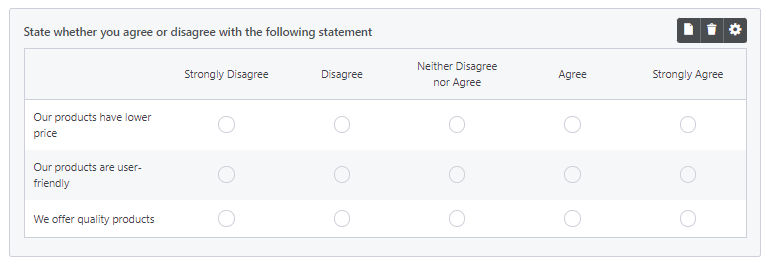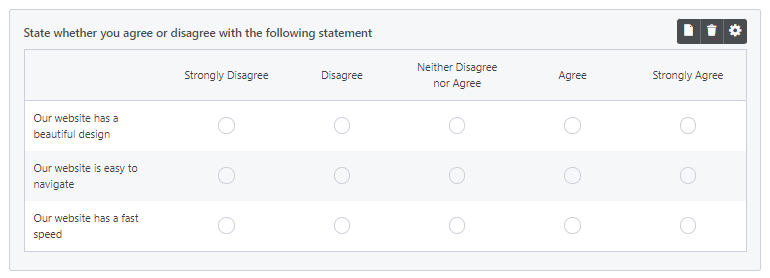You can find several types of rating scales to measure your audience’s attitude and opinion. However, the one which researchers or surveyors extensively use is the Likert scale.
Hence, this article intends to help you understand what the Likert scale is and its examples. We’ll also discuss its advantages and limitations and provide tips to create a useful Likert scale.
So, are you ready? Let’s start.
Table of Contents
What is a Likert Scale?
You might have answered the survey questions that asked about how much you agree or disagree with certain statements at least once in your lifetime. That type of scale is called the Likert scale.
It’s named after an American psychologist Rensis Likert. This psychometric scale helps you measure opinions and perspectives regarding the quality of your products, services, and so on from your audiences.
It’s a closed-ended question/statement meaning it has pre-populated answer options, as seen in the example below. And, the answer choices range from one extreme point to another, like Strongly Disagree to Strongly Agree.

Since the questions have their own set of pre-populated answers choices with positive and negative sentiments plus a neutral midpoint thus, respondents can freely provide their opinion without any pressure.
Therefore, it helps you get genuine responses for your survey research without intimidating the respondents with open-ended questions, yes/no, ranking, and other such question types.
Now that you know what the Likert scale is, it’s time to explore some of its examples.
Likert Scale Examples
The Likert scale can measure any kind of sentiments like satisfaction, frequency of the behavior, level of agreement, likelihood, and many more. Therefore, it’s widely used in psychology, social sciences, business, and marketing.
Some of the useful Likert scale examples are as follows:
1. Customer Satisfaction
Researchers broadly use the Likert scale in customer satisfaction surveys. These surveys help you gain insights into how they feel about your products and services. So, you can detect the areas of improvement to grow your business.
Likert scale example for customer satisfaction:

2. Frequency of Behavior
Likert scale survey is suitable to track the behavior of your customers, students, employees, etc. For instance, you can find out the frequency of product purchases and returns from your customers. Likewise, you can determine how often students skip classes or submit homework, etc.
Likert scale example for frequency of the behavior:

3. Level of Agreement
Likert scales are also useful to gauge respondents’ level of agreement to specific statements or questions.
Likert scale example for level of agreement:

4. Feedback Collection
It’s also possible to determine people’s overall experience about different types of training, seminars, and other such events.
Likert scale example for feedback collection:

As seen in the example above, the flexibility of the scale can help you gather valuable insights about broad topics relevant to your business. Hence, the results can be fruitful to identify the areas of improvement to make your business grow and succeed.
Likert Scale Types
There are several Likert scale points which are divided into two major types i.e., Even and Odd Likert scale.
I. Even Likert Scale
These types of scales lack neutral options. So basically, they’re also referred to as forced scales because respondents have to choose from either positive or negative ends.
- 2-Point Likert Scale: It’s the simplest type of even point scale with just two options.

- 4-Point Likert Scale: It allows respondents to choose from 4 options to collect specific responses.

- 6-Point Likert Scale: It’s the upgrade for a 4-point type with two more answer choices for collecting user opinions.

- 8-Point Likert Scale: It provides more options to express the true feelings of respondents. Thus, it has a greater degree of measurement precision. However, it’s less commonly used as it confuses respondents with too many options.
II. Odd Likert Scale
These scales types comprise of two extreme poles with neutral choice at the middle. Hence, it offers an easy option to choose when the respondents are undecided or confused.
- 3-Point Likert Scale: The simplest odd scale type has two endpoints with a neutral option at the middle.

- 5-Point Likert Scale: It consists of 5 different answer choices. This scale is easier for users to understand and respond to. Therefore, it’s considered ideal for performing more extensive surveys.

- 7-Point Likert Scale: It’s a variant of the 5-point scale type with two additional answer choices at the extreme ends. It’s easy to use and provides a better reflection of how the respondent feels.

- 9-Point Likert Scale: Here, you’ll get 9 different answer options. Since more answer choices can overwhelm the users and make them choose the answers randomly, researchers rarely use this point scale type.
Advantages and Limitations of Likert Scale
There are many advantages and disadvantages to the Likert scale survey, which are explained given below.
Advantages
The Likert scale offers several advantages that make it so popular among researchers and surveyors. They are:
- Universal Market Research Method: It’s the easiest, reliable, quick, and inexpensive survey method for data collection.
- Higher Response Rate: Respondents can easily understand the questions and choose from the wide range of answer options that make them comfortable to respond in the survey research.
- Honest Feedback Collection: Since respondents can conceal their identity, the chances are high that you get honest opinions regarding your products and services.
- Get Quantitative Data: All the responses you collect can be subjected to computation for statistical analysis.
Disadvantages
Though you get multiple benefits, there are also some drawbacks you cannot avoid. They are:
- Restricted Answer Options: The pre-populated answer choices restrict respondents from providing the most relevant answer that genuinely reflects their feelings.
- Avoiding Extreme Options: Respondents frequently tend to avoid extreme responses (Extremely Important, Strongly Agree, or Disagree) on a scale to keep themselves in a positive light.
- Fails to Provide Accurate Measurement of Attitude: Since the Likert scale is uni-dimensional, the distance between answer options may not be equidistant, referring to respondents’ lack of absolute attitude measurement.
- Not Always Possible to Get True Feedback: People often provide random responses to create a false impression of your business. Also, respondents occasionally misunderstand the questions and give wrong feedback.
How to Create Useful Likert Scale Survey?
In the previous sections, you learned the definition of the Likert scale, its examples, advantages, and disadvantages. Now, if you’re entirely new to this term, you may also want to know how to create functional Likert scales that yield effective results. So, here we’ll be discussing the same.
1. Determine What You Want to Measure
First of all, you need to think before you ink. You should be clear on what opinions, experiences, or perspectives you want to derive from your audiences regarding your business. All the questions you create and the responses you get depend on what you want to measure.
For instance, different types of sentiment you would like to measure are:
- Agreement: Strongly Disagree, Disagree, Neither Agree Nor Disagree, Agree, Strongly Agree
- Frequency: Never, Rarely, Sometimes, Often, Always
- Approval: Strongly Disapprove, Disapprove, Neutral, Approve, Strongly Approve
- Quality: Very Poor, Poor, Fair, Good, Excellent
- Importance: Extremely Important, Important, Moderately Important, Slightly Important, Not At All Important
2. Ask Multiple Questions
Likert scale generates better results when you group related questions/statements. You can sum up responses you get for the questions and analyze them to get accurate results that pinpoint the strength and limitations of the specific topic of your interests.
For instance, you can view the image below.

The Likert scale example above is focused on getting feedback about your company’s product. Hence, you can create multiple questions/statements to dig deeper about anything relevant to your business in a similar way.
Also, while writing survey questions, make sure you practice the following for better results:
- Use simple words and language that your audience understands.
- Avoid long and complex questions that bore your readers; rather keep it simple, clear, and concise.
- Stay away from biased questions that may force people to choose from the extreme answer choices.
3. Keep Your Scaling Responses Odd
Odd scales have a midpoint, so they can pick the neutral answer choices without any pressure if the respondents cannot decide.
However, choosing a scale above seven may overwhelm the respondents leading to random picking of answers options making your results meaningless. Also, using a scale below five may restrict users from expressing how they feel about the products and services. Hence, 5 to 7 point scales are ideal for the survey.
4. Make Sure to Label Your Scale
Numbered scale can confuse your respondents about which rating scale is positive and which is negative. As a result, you may get the wrong responses. Therefore, it’s wise to label the numeric responses.
For instance, you can label your scale for the statement or question as follows:
- 5 – Strongly Agree
- 4 – Agree
- 3 – Neither Agree Nor Disagree
- 2 – Disagree
- 1 – Strongly Disagree
5. Use Consistent Scale
You need to add up all the responses to measure the attitude or behavior of people towards your business. Mixing different scales within your survey can confuse your respondents and make it difficult for final analysis. Therefore, you ought to keep your scale consistent.
Analyzing Likert Scale Data
The debate on which statistics to use to analyze Likert data has been going on for a long time. Therefore, it’s essential to know what data type you are dealing with first, i.e., Likert item or Likert scale.

In the example above, the statement “Our website has a beautiful design” is a Likert item, whereas the table as a whole is a Likert scale.
The Likert items are individually evaluated to get a deeper insight into specific attributes, whereas in the latter, researchers add all the Likert items to measure a single trait.
Typically, the researchers treat the Likert items as ordinal level data where we cannot assume the distance between responses as equal. So, to analyze the ordinal scale data, mode or median are used to measure central tendency, and frequencies are used to measure variability. Similarly, you can use non-parametric tests like the Chi-square test, Mann Whitney test, etc.
Contrarily, the researchers treat the Likert scale as an interval scale where the distance between responses is assumed to be equal. One primary reason for considering it as an interval is that a composite score is obtained by adding responses to all the questions.
So, in this case, you can use the mean to calculate central tendency and standard deviation for variability. Likewise, you can use parametric tests like Pearson’s r correlation, t-test, ANOVA for analyzing data.
Conclusion
Likert Scale is one of the best survey tools to measure attitude and opinion regarding a particular subject matter of your interests. This technique makes it extremely easy for your audience to understand and respond to your questions. Thus, it’s possible to yield effective results that can guide you to improve your business.
With an outstanding WordPress plugin like Everest Forms and Survey Polls and Quiz add-on, you can easily create the Likert surveys that give results.
Now, we’re at the end of our article. Hopefully, you enjoyed reading it. If you did, consider sharing it on your social platforms.
You can also check our other articles on how to create survey forms and the best WordPress survey plugins.
Lastly, make sure to follow us on Twitter and Facebook for the latest updates.






![Zakra 3.0 | Zakra Pro 2.0 Release [Major Updates!]](https://i.ytimg.com/vi/g3rifl7kWvg/maxresdefault.jpg)